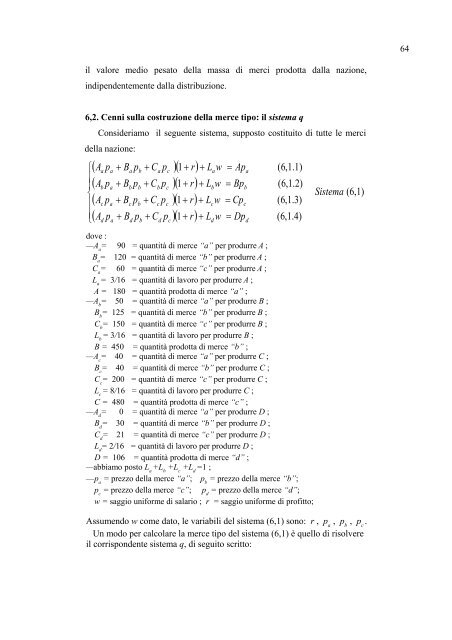Valore e misura invariabile in Ricardo e Sraffa
Valore e misura invariabile in Ricardo e Sraffa
Valore e misura invariabile in Ricardo e Sraffa
You also want an ePaper? Increase the reach of your titles
YUMPU automatically turns print PDFs into web optimized ePapers that Google loves.
il valore medio pesato della massa di merci prodotta dalla nazione,<br />
<strong>in</strong>dipendentemente dalla distribuzione.<br />
6,2. Cenni sulla costruzione della merce tipo: il sistema q<br />
Consideriamo il seguente sistema, supposto costituito di tutte le merci<br />
della nazione:<br />
<br />
<br />
<br />
<br />
<br />
<br />
<br />
Aa pa<br />
Ba<br />
pb<br />
Ca<br />
pc<br />
1 r<br />
Ab pa<br />
Bb<br />
pb<br />
Cb<br />
pc<br />
1 r<br />
Ac pa<br />
Bc<br />
pb<br />
Cc<br />
pc<br />
1 r<br />
A p B p C p 1 r<br />
d<br />
a<br />
d<br />
b<br />
d<br />
c<br />
L<br />
L w<br />
b<br />
L w<br />
c<br />
L<br />
a<br />
d<br />
w<br />
w<br />
Ap<br />
Bp<br />
Cp<br />
b<br />
c<br />
Dp<br />
a<br />
d<br />
( 6,1.1)<br />
( 6,1.2)<br />
( 6,1.3)<br />
( 6,1.4)<br />
dove :<br />
—A a = 90 = quantità di merce “a” per produrre A ;<br />
B a = 120 = quantità di merce “b” per produrre A ;<br />
C a = 60 = quantità di merce “c” per produrre A ;<br />
L a = 3/16 = quantità di lavoro per produrre A ;<br />
A = 180 = quantità prodotta di merce “a” ;<br />
—A b = 50 = quantità di merce “a” per produrre B ;<br />
B b = 125 = quantità di merce “b” per produrre B ;<br />
C b = 150 = quantità di merce “c” per produrre B ;<br />
L b = 3/16 = quantità di lavoro per produrre B ;<br />
B = 450 = quantità prodotta di merce “b” ;<br />
—A c = 40 = quantità di merce “a” per produrre C ;<br />
B c = 40 = quantità di merce “b” per produrre C ;<br />
C c = 200 = quantità di merce “c” per produrre C ;<br />
L c = 8/16 = quantità di lavoro per produrre C ;<br />
C = 480 = quantità prodotta di merce “c” ;<br />
—A d = 0 = quantità di merce “a” per produrre D ;<br />
B d = 30 = quantità di merce “b” per produrre D ;<br />
C d = 21 = quantità di merce “c” per produrre D ;<br />
L d = 2/16 = quantità di lavoro per produrre D ;<br />
D = 106 = quantità prodotta di merce “d” ;<br />
—abbiamo posto L a +L b +L c +L d =1 ;<br />
—p a = prezzo della merce “a”; p b = prezzo della merce “b”;<br />
p c = prezzo della merce “c”; p d = prezzo della merce “d”;<br />
w = saggio uniforme di salario ; r = saggio uniforme di profitto;<br />
Sistema (6,1)<br />
Assumendo w come dato, le variabili del sistema (6,1) sono: r , p a , p b , p c .<br />
Un modo per calcolare la merce tipo del sistema (6,1) è quello di risolvere<br />
il corrispondente sistema q, di seguito scritto:<br />
64
















